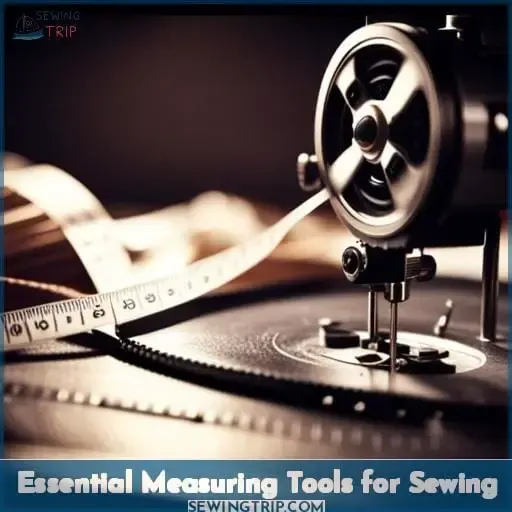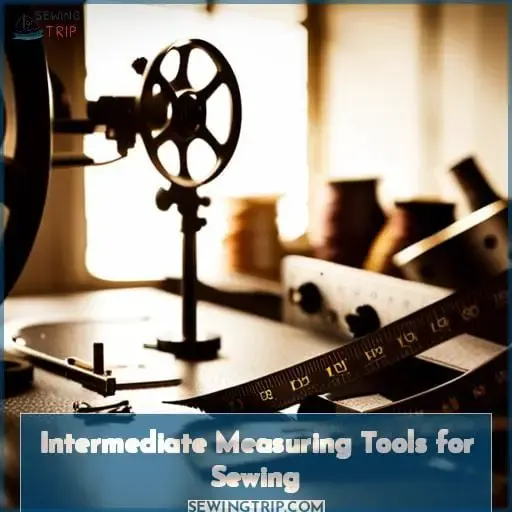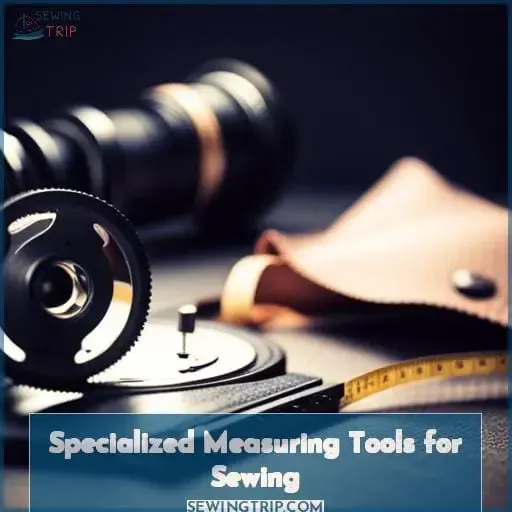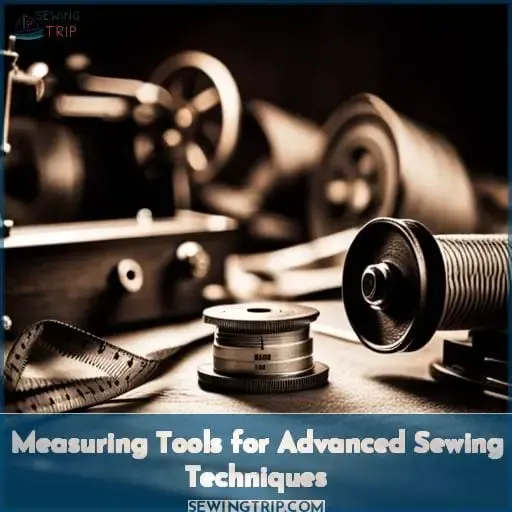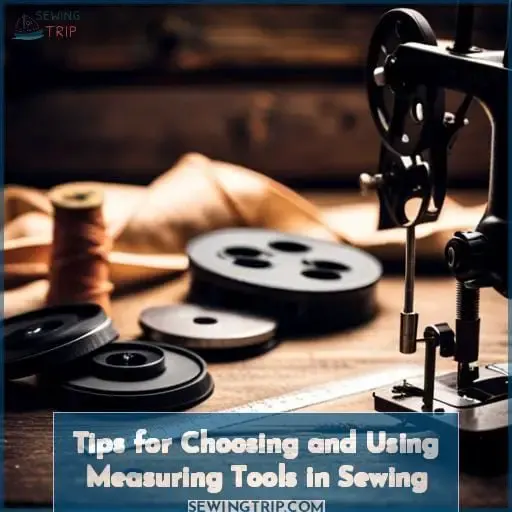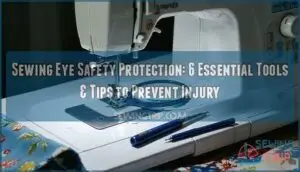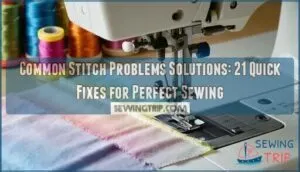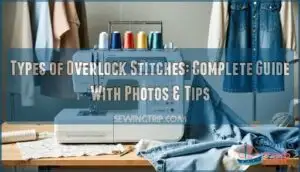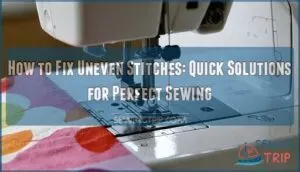This site is supported by our readers. We may earn a commission, at no cost to you, if you purchase through links.
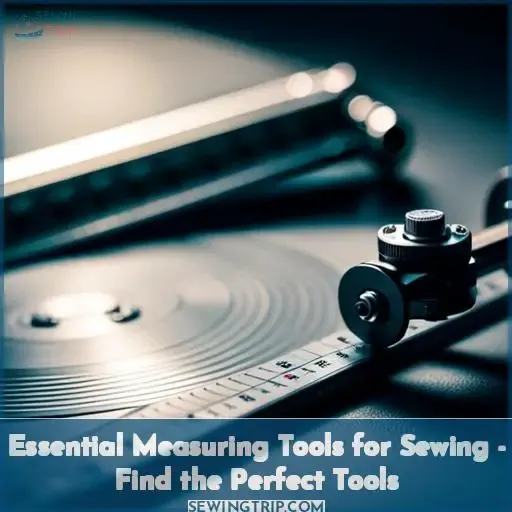 Revving up that sewing machine can be daunting without the right tools in hand. When it comes to creating quality garments and projects, measuring is essential – so having a dependable toolkit of measurement instruments is key!
Revving up that sewing machine can be daunting without the right tools in hand. When it comes to creating quality garments and projects, measuring is essential – so having a dependable toolkit of measurement instruments is key!
From traditional rulers and tape measures to specialized devices like pattern masters and tracers, there are plenty of options available for sewists at any level.
With our guide on essential measuring tools for sewing, you’ll find the perfect solutions to equip your workroom with confidence.
Table Of Contents
Key Takeaways
- Measuring tools for sewing include essential tools like a measuring tape, ruler, and seam gauge, as well as specialized tools like a pattern master and quilting ruler.
- Precision measurement techniques and calibration standards are important to ensure accurate measurements in sewing projects.
- Proper technique and tool maintenance should be emphasized to ensure the longevity and accuracy of measuring tools.
- Alternative measuring methods such as pins, digital calipers, and 3D scanning can also be considered for specific sewing applications.
Essential Measuring Tools for Sewing
When it comes to sewing, having the right measuring tools is essential. The three key measuring tools every sewer should have in their toolkit are a measuring tape, ruler, and seam gauge. These tools will ensure accurate measurements for precise cuts and seams in your sewing projects.
Measuring Tape
Grab your trusty measuring tape and get ready to take accurate measurements for sewing projects! A measuring tape is an essential tool that allows you to measure fabric, body dimensions, and other sewing components with precision.
It offers flexibility in its use, making it suitable for various applications. If you prefer alternatives to a traditional measuring tape, clear rulers or yardsticks can also be used. Remember to select a reliable and durable measuring tape, care for it properly by keeping it clean, and store it away from extreme temperatures.
Ruler
Take hold of a ruler, like a straight line in the sand, guiding your measurements with precision and accuracy. With its long, flat shape and marked increments, the ruler is an essential tool for any sewing project.
Here are four tips to make the most out of this versatile measuring instrument:
- Use it as a guide: Place the ruler against fabric edges or seams to ensure precise cuts and seam allowances.
- Measure accurately: Align one end of the ruler at your starting point and read measurements from where you need them.
- Take advantage of markings: Many rulers have additional lines or dots that can assist in pattern placement or marking reference points.
- Invest in specialty rulers: Quilting rulers, sewing gauges, and pattern measuring tools offer specific features tailored to different projects.
Seam Gauge
Make sure to have a seam gauge on hand, as it is an essential tool for accurately marking and measuring fabric seams. The versatility of the seam gauge allows you to take precise measurements for various sewing projects.
Whether you are working on dressmaking or hemming, the seam gauge ensures that your measurements are accurate and consistent. While there may be alternatives like rulers or tape measures, a dedicated seam gauge provides greater precision and ease of use in sewing applications.
Intermediate Measuring Tools for Sewing
For intermediate sewing projects, you’ll need a few additional measuring tools to ensure accurate and precise results. The French Curve, Hip Curve, and Grading Ruler are essential tools that will help you achieve professional-looking garments with ease.
French Curve
Use the French Curve to effortlessly create smooth and graceful curves in your sewing projects, adding an elegant touch to your designs. This versatile tool is commonly used in fashion design and pattern making due to its ability to accurately replicate various curve shapes.
There are different types of French Curves available, each designed for specific applications such as armholes, necklines, or sleeves. While there are alternative methods for creating curves, the French Curve remains a popular choice among intermediate sewers for its precision and ease of use.
Hip Curve
Create sleek and stylish garments that perfectly hug your curves by utilizing the versatile and essential Hip Curve. This measuring tool is specifically designed to help you achieve precise sewing measurements for curved areas such as hips, waistlines, and armholes.
With a gentle curve that mimics the natural contours of the body, the Hip Curve allows for accurate pattern drafting and alterations. It is an indispensable tool for any sewer looking to create well-fitting garments with professional-looking curves.
Sewing Measurements:
- Hips: Measure hip circumference accurately
- Waistline: Achieve a smooth curve at the waistline
- Armholes: Create properly fitting armhole shapes
When working on sewing projects that require accurate measurements of curved areas like hips or armholes, using a Hip Curve can make all the difference in achieving precise results. The unique shape of this measuring tool ensures that your garment fits smoothly around these curvy parts of your body, enhancing both comfort and style.
If you’re looking for alternatives to traditional straight rulers when it comes to sewing curved lines on patterns or making adjustments during fittings, don’t overlook this valuable addition to your toolkit – the trusty Hip Curve! Whether you’re new to sewing or an experienced seamstress aiming for perfection in every stitch, incorporating specialized tools like this can greatly enhance accuracy while saving time throughout each step of garment construction.
Organizational readiness assessment tools play a vital role in ensuring health information technology implementation success.
Grading Ruler
With the Grading Ruler, you can effortlessly shape and adjust patterns to create perfectly graded sizes for your sewing projects. This versatile tool allows for precise measurements and accurate grading of garments.
However, if you’re looking for alternatives or want to enhance your measuring accuracy, there are other options available. Consider using a tailor’s L square or a curved runner as they provide different angles and curves that may better suit your needs.
Explore different ruler selections to find the one that best fits your grading ruler techniques and ensures optimal measuring precision in all of your sewing endeavors.
Specialized Measuring Tools for Sewing
When it comes to sewing, having the correct measuring tools is essential for accurate and precise work. Specialized tools such as the Pattern Master, Tailor’s Chalk, and Tracing Wheel are specifically designed to assist you in taking measurements and marking fabric with ease.
Pattern Master
Master the art of sewing with the Pattern Master, a specialized tool that will revolutionize your pattern-making process and unleash your creativity. The Pattern Master is designed to help you achieve sewing precision by providing accurate measurements for garment fitting.
With its advanced technological readiness, this tool enables you to create intricate patterns with ease. Whether you’re a beginner or an experienced seamstress, the Pattern Master offers pattern-making tips and ensures sewing accuracy in every project.
Take your sewing skills to new heights with this essential addition to your sewing kit.
Tailor’s Chalk
Take your tailor’s chalk and confidently mark the fabric, leaving behind precise lines that will guide you as you bring your sewing project to life. Tailor’s chalk is an essential tool for fabric marking in sewing techniques. It allows you to trace patterns accurately onto the fabric, ensuring a perfect fit for your garment.
With its easy application and visibility on various fabrics, tailor’s chalk helps assess readiness by providing clear guidelines for core readiness, IT skills readiness, engagement readiness, and acceptance and use readiness in sewing projects.
Tracing Wheel
Use a tracing wheel to effortlessly transfer your pattern onto fabric, letting you measure twice, cut once, and ensure precise sewing every time.
Tracing wheels are versatile tools that can be used for various fabric marking methods. By rolling the sharp-edged wheel over your paper pattern on top of the fabric, it creates small punctures or dents in the material.
These marks act as guidelines for cutting and stitching accurately, ensuring precision in your sewing projects.
While there are alternative methods available, such as tailor’s chalk and marking pens, tracing wheels provide a unique level of accuracy that is hard to replicate with other tools.
Measuring Tools for Advanced Sewing Techniques
When it comes to advanced sewing techniques, there are a few essential measuring tools that can greatly improve your precision and accuracy. These include the quilter’s ruler for precise fabric cutting, the bias tape maker for creating custom bias tapes with ease, and the measuring gauge for accurate measurements of hems, pleats, and buttonholes.
Quilter’s Ruler
Start by grabbing a quilter’s ruler, an essential tool for precise measurements in advanced sewing techniques. The quilter’s ruler is specifically designed with marked measurements and angles to assist in quilting techniques such as fabric cutting and patchwork precision.
Its clear layout allows for accurate alignment when measuring, and its durable construction ensures longevity. With a quilter’s ruler, you can easily achieve the desired quilt design while maintaining accuracy throughout your project.
Bias Tape Maker
Create professional bias tape effortlessly with a Bias Tape Maker. Can you imagine the endless possibilities for beautifully finished edges on your sewing projects? The Bias Tape Maker is a handy tool that helps you create custom bias tape from any fabric of your choice.
It allows for precise folding and pressing, resulting in perfectly even strips of bias tape. With this tool, you can explore various sewing techniques like fabric manipulation and add creative touches to your sewing projects.
Measuring Gauge
Take out your handy measuring gauge, a versatile tool that helps you accurately measure and mark fabric for various sewing techniques. The measuring gauge is used to ensure precise measurements for hems, seam allowances, pleats, and buttonhole placements.
With its adjustable slider or ruler-like design, it allows you to quickly adjust the desired measurement without the need for multiple tools. Made from durable materials like metal or plastic, this tool requires minimal maintenance and can last a lifetime with proper care.
Innovations in digital measuring gauges have also emerged recently, offering even greater accuracy and functionality in garment construction.
Tips for Choosing and Using Measuring Tools in Sewing
When it comes to sewing, using the right measuring tools is essential for achieving quality and accuracy in your projects. In this guide, we will provide you with tips on choosing the best measuring tools for your needs, as well as techniques to ensure proper usage and care.
Plus, we’ll explore alternative methods of measurement that can come in handy when traditional tools are not available or suitable for a particular task.
Quality and Accuracy
Ensure the precision of your sewing projects by using instruments that act as a compass, guiding you towards quality and accuracy like a North Star.
- Precision measurement techniques: Utilize advanced methods for accurate measurements.
- Calibration standards: Regularly calibrate your measuring tools to ensure accuracy.
- Measurement uncertainty analysis: Understand and analyze potential errors in your measurements.
- Metrology advancements: Stay updated on new developments in industrial measurement tools to enhance precision.
Proper Technique and Care
Maintain the accuracy and longevity of your sewing equipment by learning proper techniques and care. To ensure precise handling, always use measuring tools with a steady hand and avoid applying excessive force.
Clean your tools regularly to prevent buildup or damage that could affect their accuracy. Store them in a dry place away from moisture or extreme temperatures to preserve their quality. Following these care guidelines will help you maintain the reliability of your measuring tools for years to come.
Alternative Measuring Methods
Try using different methods of measurement to obtain accurate results, such as using pins or clips instead of traditional measuring instruments like rulers or tape measures. Digital calipers offer precise measurements and are easy to read, while laser measurement tools provide quick and efficient measurements over long distances.
3D scanning technology allows for detailed measurements of complex shapes and surfaces. Ultrasonic distance meters are useful for measuring distances that cannot be reached physically. Infrared thermometers measure temperature without direct contact with the object being measured.
Conclusion
You’ve come this far, and now it’s time to put the finishing touches on your sewing project. You want to be sure you have the right tools to get the job done right. From the essential measuring tools, like a measuring tape and ruler, to the specialized tools, like a pattern master and bias tape maker, it’s important to choose the right tools to ensure accuracy and quality.
Knowing your options and the proper technique for using them will give you the confidence to take on any project. With the right measuring tools, you’ll be able to achieve the perfect measurements every time for a successful sewing project.

